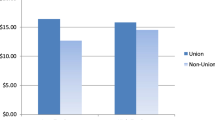Abstract
This paper examines the effect of the political power of public sector unions on the composition of public sector compensation. Public employee unions provide a relatively low-cost vehicle for organizing workers’ political activity in support of the rent-seeking behavior of local politicians. The unions also provide a conduit for employees to capture part of these rents as payment for political services. Since the public has little interest in paying for the political activities of public workers, these payments are most likely to be made through fringe benefits so as to minimize public scrutiny.
Similar content being viewed by others
References
Bartel, Ann and David Lewin. “Wages and Unionism in the Public Sector: The Case of Police.”Review of Economics and Statistics 63 (February 1981): 53–59.
Bellante, Don and James Long. “The Political Economy of the Rent-Seeking Society: The Case of Public Employees and Their Unions.”Journal of Labor Research 2 (Spring 1981): 1–14.
Benecki, Stanley. “Municipal Expenditure Levels and Collective Bargaining.”Industrial Relations 17 (May 1978): 216–30.
Bennett, James T. and William Orzechowski. “The Voting Behavior of Bureaucrats: Some Empirical Evidence.”Public Choice 41 (Winter 1983): 271–84.
Bush, Winston C. and Arthur Denzau. “The Voting Behavior of Bureaucrats and Public Sector Growth” inBudgets and Bureaucrats, ed. Thomas C. Borcherding. Durham, N.C.: Duke University Press, 1977.
Cohen, Sanford. “Does Public Employee Unionism Diminish Democracy?”Industrial and Labor Relations Review 32 (January 1979): 189–95.
DiLorenzo, Thomas J. “Exclusive Representation in Public Employment: A Public Perspective.”Journal of Labor Research 5 (Fall 1984): 371–83.
Edwards, Linda N. and Franklin R. Edwards. “Wellington-Winters Revisited: The Case of Municipal Sanitation Collection — Replay.”Industrial and Labor Relations Review 35 (April 1982): 307–18.
_____. “Public Unions, Local Government and the Compensation of Municipal Sanitation Workers.”Economic Inquiry 20 (July 1982): 405–25.
Fogel, Walter and David Lewin. “Wage Determination in the Public Sector.”Industrial and Labor Relations Review 27 (April 1974): 410–31.
Freeman, Richard B. “The Effect of Unionism on Fringe Benefits.”Industrial and Labor Relations Review 3 (July 1981): 489–509.
Gramlich, E.M. “New York: Ripple or Tidal Wave?American Economic Review 66 (May 1965): 415–29.
Hall, W. Clayton and Bruce Vanderporten. “Unionization Monopsony Power and Police Salaries.”Industrial Relations 16 (February 1977): 94–100.
Hunt, Janet C. and Randolph White. “The Legal Status of Collective Bargaining by Public School Teachers.”Journal of Labor Research 4 (Summer 1983): 213–24.
Hunter, William J. “The Impact of Labor Cost on Municipal Finances.”Public Choice 38 (1982): 139–47.
Ichniowski, Casey. “Economic Effects of the Firefighters’ Union.”Industrial and Labor Relations Review 33 (January 1980): 198–211.
Lewin, David. “Public Sector Labor Relations: A Review Essay.”Labor History 18 (Winter 1977): 133–44.
Lentz, Bernard F. “Political and Economic Determinants of County Government Pay.”Public Choice 39 (1981): 253–71.
_____. Public Sector Wage Determination: A Democratic Theory of Economics. Unpublished dissertation, Yale University (1976).
Niskanen, William A. “Bureaucrats and Politicians.”Journal of Law and Economics 18 (December 1975): 617–43.
Perkinson, Leon B. and Robert M. Fearn. “Wellington-Winter Revisited: The Case of Municipal Sanitation Collection-Comment.”Industrial and Labor Relations Review 36 (July 1983): 655–57.
Pindyck, Robert S. and Daniel L. Rubenfeld.Econometric Models and Economic Forecasting. New York, McGraw-Hill, 1981.
Shapiro, David. “Relative Wage Effects of Unionism in the Public and Private Sectors.”Industrial and Labor Relations Review 31 (January 1978): 193–204.
Smith, Sharon P. “Government Wage Differentials.”Journal of Urban Economics 4 (July 1977): 248–71.
Spilman, L. “Public Employee Unions: A Study in the Economics of Power.”Journal of Labor Research 1 (Fall 1980): 265–73.
Stanley, David T.Managing Local Government Under Union Pressure. Washington, D.C.: Brookings Institution, 1972.
Summers, Clyde. “Public Employee Bargaining: A Political Perspective.”Yale Law Journal (May 1974), 1156–1200.
Summers, Robert S.Collective Bargaining and Public Benefit: A Jurisprudential Critique. Ithaca: Institute of Public Employment, New York State School of Industrial Relations, 1976.
Tullock, Gordon. “Dynamic Hypothesis on Bureaucracy.”Public Choice 19 (Fall 1974): 127–31.
Wellington, Harvey H. and Ralph K. Winter.The Unions and the Cities. Washington, D.C.: The Brookings Institution, 1971.
_____. “The Limits of Collective Bargaining in Public Employment.”Yale Law Journal 78 (June 1969): 1123–27.
Author information
Authors and Affiliations
Additional information
The authors would like to thank an anonymous referee for helpful suggestions. Any errors remain those of the authors.
Rights and permissions
About this article
Cite this article
Hunter, W.J., Rankin, C.H. The composition of public sector compensation: The effects of unionization and bureaucratic size. Journal of Labor Research 9, 29–42 (1988). https://doi.org/10.1007/BF02685227
Issue Date:
DOI: https://doi.org/10.1007/BF02685227




